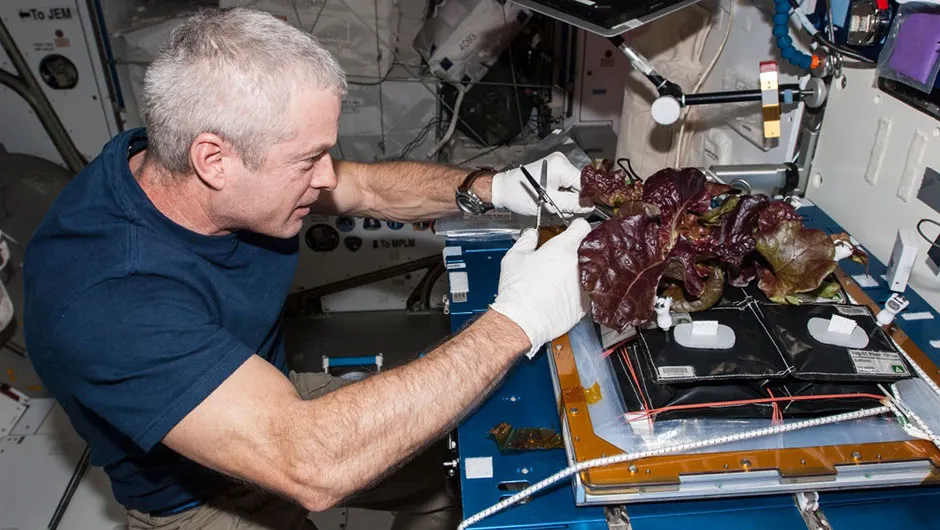Is it possible to grow plants on the Moon?
One of the most iconic images of recent sci-fi cinema is in the 2015 movie The Martian, in which astronaut Mark Watney (played by Matt Damon), manages to grow potatoes while stranded on Mars.
Which begs the question as to how easy it would be for humans to grow crops and other plants on distant worlds, such as Mars or even the Moon.
Experiments are already well underway to grow crops on the International Space Station, given the benefits of astronauts on long-duration missions being able grow their own food.

One experiment looking into the science behind whether it's possible to grow plants on the Moon is LEAF, the Lunar Effects on Agricultural Flora.
LEAF is a plant growth chamber, similar to those used in indoor farms on Earth.
It's one of a suite of science instruments selected for the Artemis III mission, which will return humans to the surface of the Moon for the first time since the Apollo era.
The aim of LEAF is to see whether plants can grow on the Moon, and whether this could be a viable way of enabling lunar astronauts to become self-sustainable.
With the discovery of water ice at the lunar south pole, where the Artemis III mission will be based, it seems like any lunar settlement there may be able to harvest a supply of water, so what about growing crops and other plants?
Christine Escobar is a researcher in bioastronautics and vice president of Space Lab, which looks at sustainably advancing human space exploration.
She's Principal Investigator of the LEAF team, and we got the chance to ask her more about how possible it might be to grow plants on the Moon.

What is the LEAF experiment?
LEAF provides the plants with everything that they need to survive – water, nutrients, light, a comfortable climate – but also protects them from the extreme environment in space.
The instrument will observe plants as they grow, monitoring their growth, shapes and colours, as well as how they exchange gases with their environment in photosynthesis.
We’ll also conduct investigations at a biomolecular level to look at how the plants change their behaviour to protect themselves in space environments.
How does LEAF fit into the Artemis III mission?
Artemis III will be the first mission to return humans to the Moon’s surface since Apollo just over 50 years ago, and is planned to launch no earlier than September 2026.
LEAF has been selected as one of the instruments.
The crew will take the chamber onto the surface of the Moon, deploy and initialise it.
The chamber will deliver water to seeds, encouraging growth. Images and data will be transmitted back to Earth.
The crew will collect samples to take back when they leave a few days later.
But some samples will be left behind in the chamber to keep growing until the system runs out of power, as long as two weeks later.
If LEAF is successfully deployed, it will be the first time that human beings have grown and harvested plants on the Moon.
The first plant grown on the Moon was a cotton seedling carried by Chang’e 4’s lunar lander.

How is the LEAF chamber protected against the challenges of space flight?
First of all, there are extreme temperature swings: very hot when you’re in sunlight with no protective atmosphere, and very cold when the Sun is gone.
LEAF needs a lot of thermal protection, both to keep the plants warm and to stop them overheating.
We also have to provide them with air, from which they need carbon dioxide.
The plants will also be exposed to the elevated radiation in space that our atmosphere protects us from on Earth, as well as partial gravity.
Plants will sense the difference in gravity and radiation, and alter their physiological response.
What will happen to the plants?
We have several predictions.
Plants regulate photosynthesis and growth according to the conditions they’re exposed to.
If they’re under environmental stress, they might slow down their metabolism to conserve their resources.
They might produce compounds that would protect them from damaging radiation in space – for example, antioxidants or other pigments.
Just like humans produce pigments to protect themselves from the Sun, plants may also produce compounds to protect themselves from space radiation.
We’re particularly interested in looking at how this environment might boost their antioxidant production, as these compounds may have nutritional benefit for the crew.

What kind of plants are going to be grown?
We’re taking three varieties: Wolffia or ‘watermeal’; Brassica rapa, which is related to turnips; and Arabidopsis thaliana or ‘thale cress’.
We wanted plants that have been grown in space before, like those grown in low Earth orbit on the International Space Station, so that we have data to compare to.
We also wanted to choose plants that we believe will be resilient in this environment and have characteristics that we predict may help them survive.
Watermeal plants produce a lot of antioxidants, for example.
Why is LEAF so important?
Human space exploration is the biggest sustainability challenge there is: you are trying to live in a small, isolated environment with very few resources.
You have limited access to Earth to rescue you, or at least not quickly.
I think if we can learn to live sustainably there, this can also instruct us in how to conserve our resources better here on this planet.
This interview appeared in the July 2024 issue of BBC Sky at Night Magazine.
